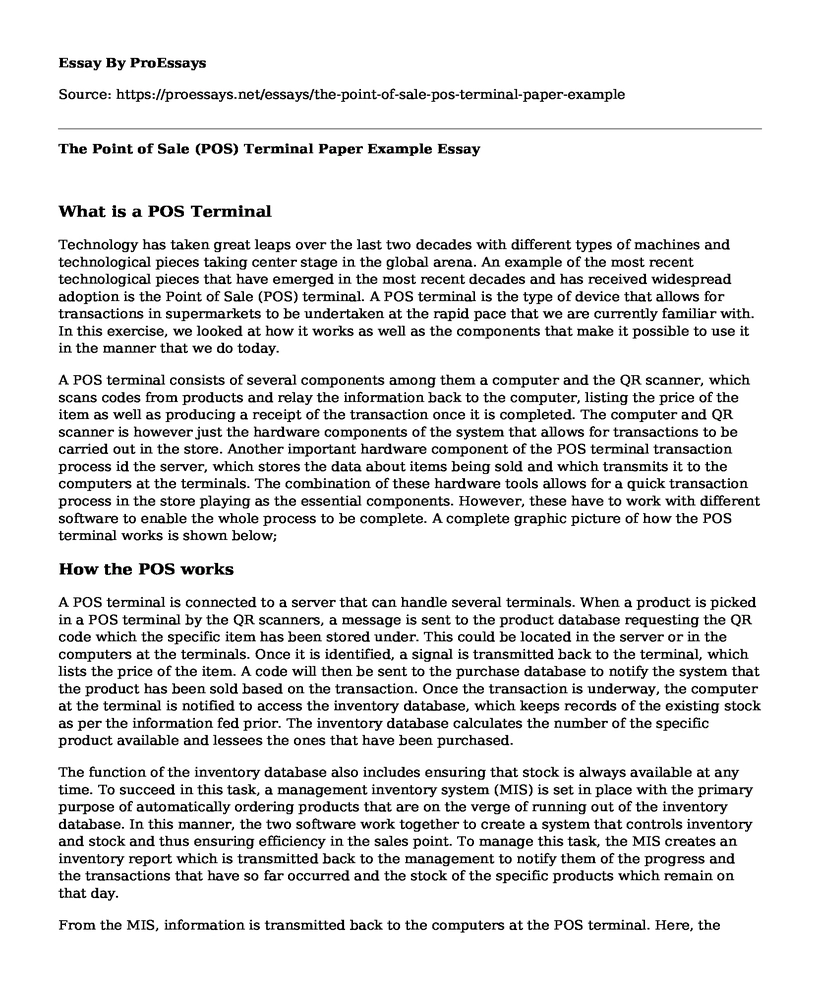What is a POS Terminal
Technology has taken great leaps over the last two decades with different types of machines and technological pieces taking center stage in the global arena. An example of the most recent technological pieces that have emerged in the most recent decades and has received widespread adoption is the Point of Sale (POS) terminal. A POS terminal is the type of device that allows for transactions in supermarkets to be undertaken at the rapid pace that we are currently familiar with. In this exercise, we looked at how it works as well as the components that make it possible to use it in the manner that we do today.
A POS terminal consists of several components among them a computer and the QR scanner, which scans codes from products and relay the information back to the computer, listing the price of the item as well as producing a receipt of the transaction once it is completed. The computer and QR scanner is however just the hardware components of the system that allows for transactions to be carried out in the store. Another important hardware component of the POS terminal transaction process id the server, which stores the data about items being sold and which transmits it to the computers at the terminals. The combination of these hardware tools allows for a quick transaction process in the store playing as the essential components. However, these have to work with different software to enable the whole process to be complete. A complete graphic picture of how the POS terminal works is shown below;
How the POS works
A POS terminal is connected to a server that can handle several terminals. When a product is picked in a POS terminal by the QR scanners, a message is sent to the product database requesting the QR code which the specific item has been stored under. This could be located in the server or in the computers at the terminals. Once it is identified, a signal is transmitted back to the terminal, which lists the price of the item. A code will then be sent to the purchase database to notify the system that the product has been sold based on the transaction. Once the transaction is underway, the computer at the terminal is notified to access the inventory database, which keeps records of the existing stock as per the information fed prior. The inventory database calculates the number of the specific product available and lessees the ones that have been purchased.
The function of the inventory database also includes ensuring that stock is always available at any time. To succeed in this task, a management inventory system (MIS) is set in place with the primary purpose of automatically ordering products that are on the verge of running out of the inventory database. In this manner, the two software work together to create a system that controls inventory and stock and thus ensuring efficiency in the sales point. To manage this task, the MIS creates an inventory report which is transmitted back to the management to notify them of the progress and the transactions that have so far occurred and the stock of the specific products which remain on that day.
From the MIS, information is transmitted back to the computers at the POS terminal. Here, the actual products are calculated and recorded down after which does a calculation of all the products purchased by the customer. At this point, information is sent to the receipt machine, which prints out the receipt listing the specific items purchased by the customer and ends the transaction with a paper copy for the customer.
The efficiency of the technology allows the system to undertake all the above-listed transactions in just a matter of seconds, demonstrating the extent to which technology has changed our lives today.
Installing a POS System
To install the POS system in a business premise, one only requires the hardware and software capable of handling the tasks listed above. Those include the server machine, which is connected to the terminal. At the terminal are receipt printers and QR scanners which are connected to the computer and which ultimately co-ordinates all the transactions as they arise. To operate efficiently, the POS terminal is dependent mainly on the three databases mentioned above. It is the harmonious working of all those systems that enable transactions to continue smoothly and with the efficiency witnessed with the introduction of this technology in businesses.
In this short issue, we have discussed the components that make up a POS terminal technology and demonstrated the processes employed to ensure the efficient working of the system in retail and other sales businesses. It is undoubtedly that this small piece has brought about a lot of changes in how we know businesses and shopping today. Yet its simplicity puzzles the mind given that people think of it as complex. However, the above is all that is involved in the technology, and now you know.
Cite this page
The Point of Sale (POS) Terminal Paper Example. (2022, Oct 03). Retrieved from https://proessays.net/essays/the-point-of-sale-pos-terminal-paper-example
If you are the original author of this essay and no longer wish to have it published on the ProEssays website, please click below to request its removal:
- Appropriate Portfolio for the XYZ to Allocate Fund and Additional Resources
- Market Research and Strategies Paper Example
- Non-Profits' Impact on US Military Veterans: Service Delivery - Research Paper
- AI in Public Health: Revolutionizing Healthcare in Digital Era - Essay Sample
- Work-Life Balance: Improving Employee Morale & Performance - Essay Sample
- Paper Example on Introduction to Marketing Tasks & Quality of Service
- Essay Example on equal Opportunities & Benefits: Techfite's Corporate Policy A & B







